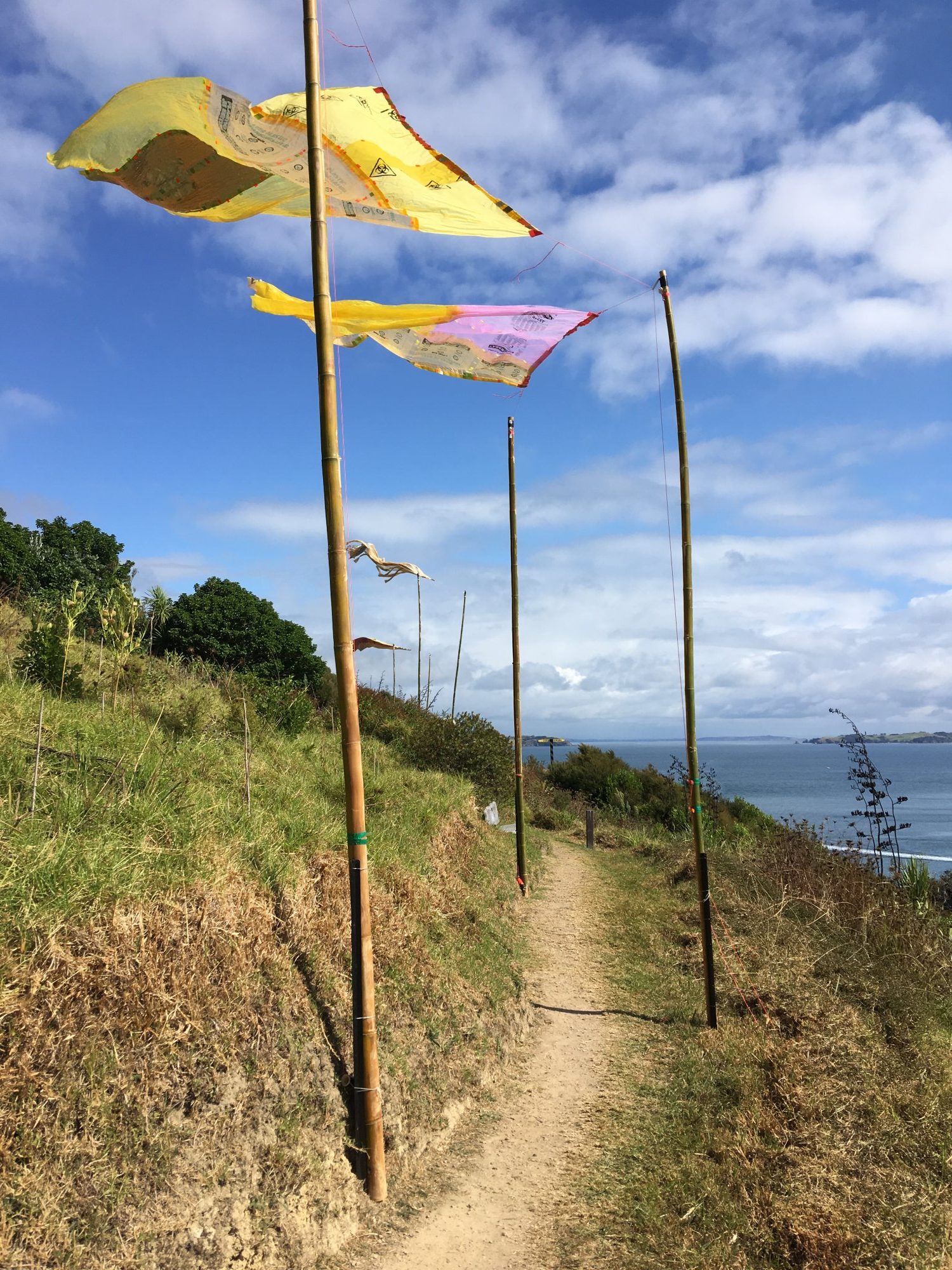
Brydee Rood A Dance That Lasts Forever, 2019
Assorted rubbish bags and saved single use plastics, survival blankets, bamboo, tape, builders twine. Dimensions variable.
As the work creates a movement with the wind and the site, it reflects the dance of our consumed traces repeating in nature. Echoing the drift of micro-plastics carried in the elements a dance of dire consequence for ocean habitats and marine species. By hoisting large colour sheets to the wind, soft plastic compositions flutter on lines that lean and tilt with a precarity that is true to its context. I am placing the material again in our path, floating visibly in our mind’s eye. A dance that passes through our touch so fleetingly yet a dance that lasts forever.
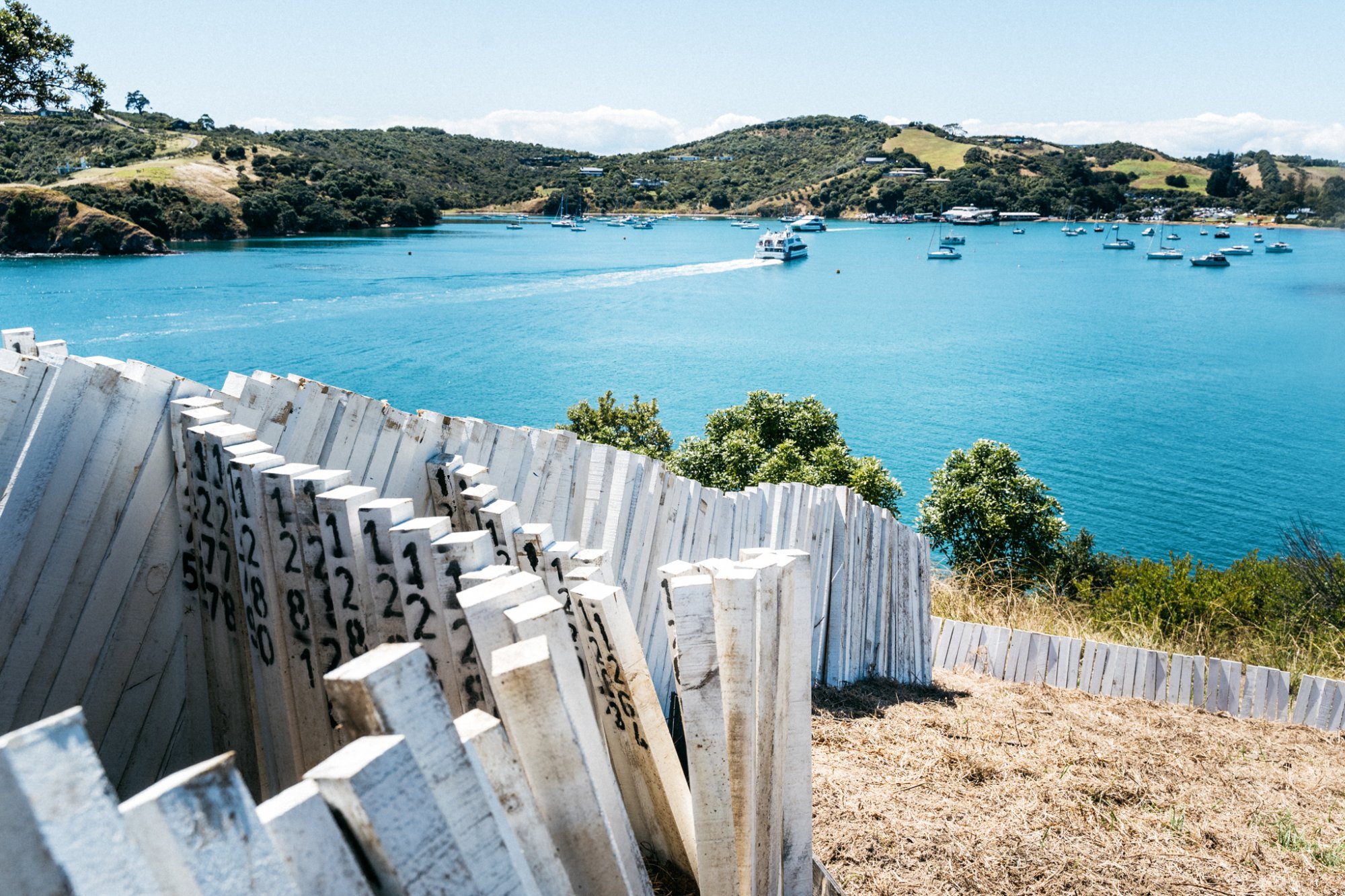
Anton Forde Pen to Peace to Peaceful Pen, 2019
1881 numbered Treated Pine Survey Pegs, 2000 Plastic supports and Te Whetūmatarau Whenua
Every day we interact with ourselves, each other, and land. Most of us have a relationship with a survey peg whether we like it or not. Most of us also interact or have some form of relationship with birds/manu. You are asked to participate in this evolving sculpture, which remembers the first peaceful protests of the past, the recognition of wrongdoing through the signing of a formal apology in 2017, and the little birds/manu that are symbols of a new dawn of peace, beauty and hope.
Inspired by and dedicated to all who have stood strong under the passive resistance movement kauapapa/ philosophy founded by Parihaka Prophets Tohu Kakahi and Te Whiti O Rongomai and those that received an apology by the Government received 49,524 days later.
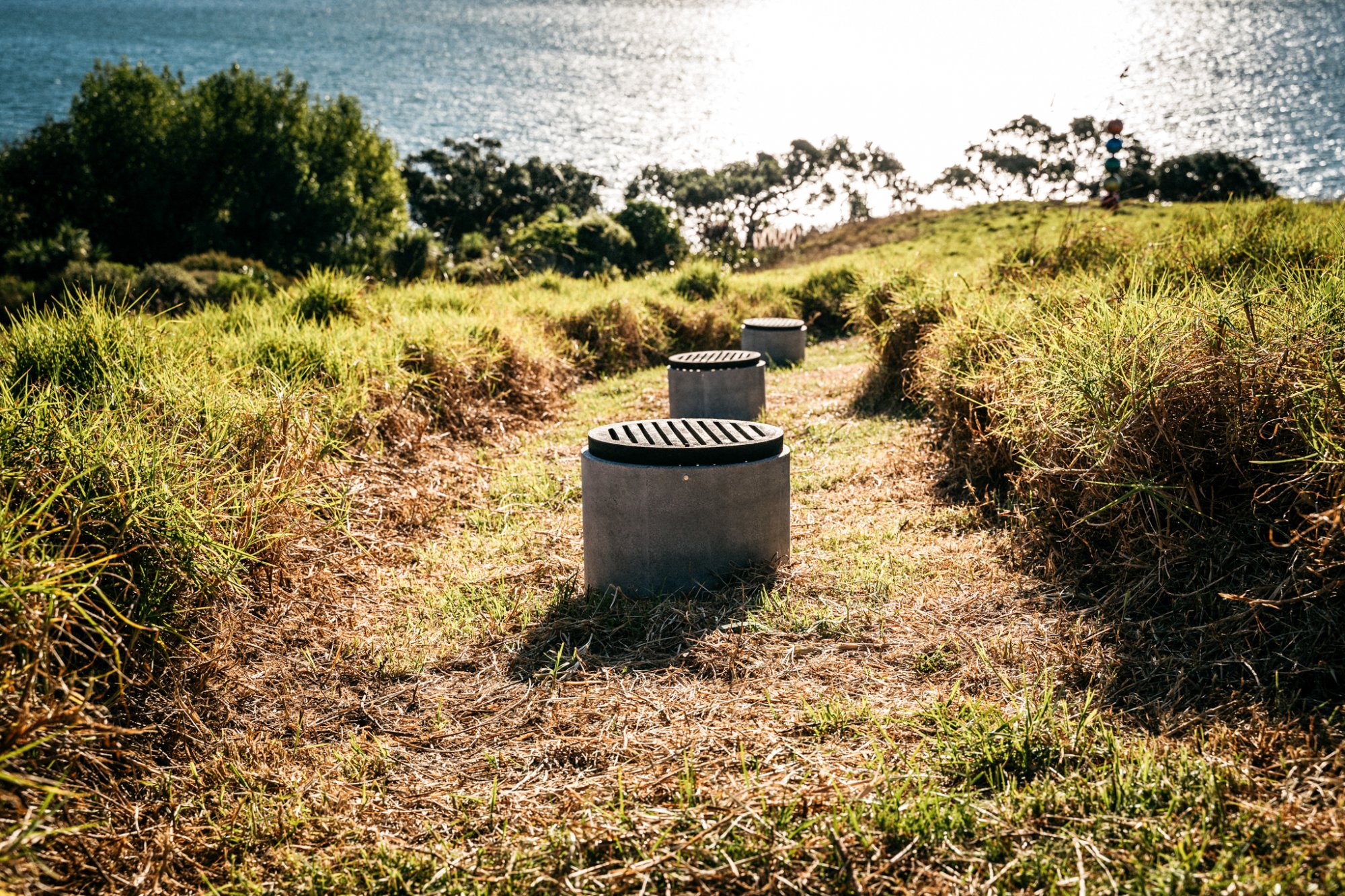
Sharonagh Montrose A Lay of the Land, 2019
Boxing, short drain pipes, gravel, batteries, solar panels and sound equipment, dimensions variable.
For many, it is all about the view! It draws the gaze outward to sky and sea, beyond the sweeping contours and internal splendour. In conceiving and making this work, I was held in thrall by the jauntiness of movement within the outline of the headland; branches and leaves, grass and rocks shifted vision constantly as they responded to light, to wind and to tides. They reminded me of musical notation where each note retains a fluidity of expression, held in sway to time and orchestration. I wondered how this coastal outline would sound if placed into music.
Composer Gisèle Hill has created a sonic composition that communicates the physical description of the coastal outline with intertwining reference to geology and topography; Treble – as defined by notes abstracted from the visual geography of the coastal landscape; Bass – as defined by the maritime chart of depth and tidal change over the last century; Syncopation – as defined by topographical landscape; Refrain – as defined by the natural coastal soundscape; Tempo – as defined by specific protuberances and depressions in the landscape at the point where land meets sea. The sonic wave form speaks to the ear and to the body in visceral communication. We often forget that sound touches more than the ear: It touches all the senses.
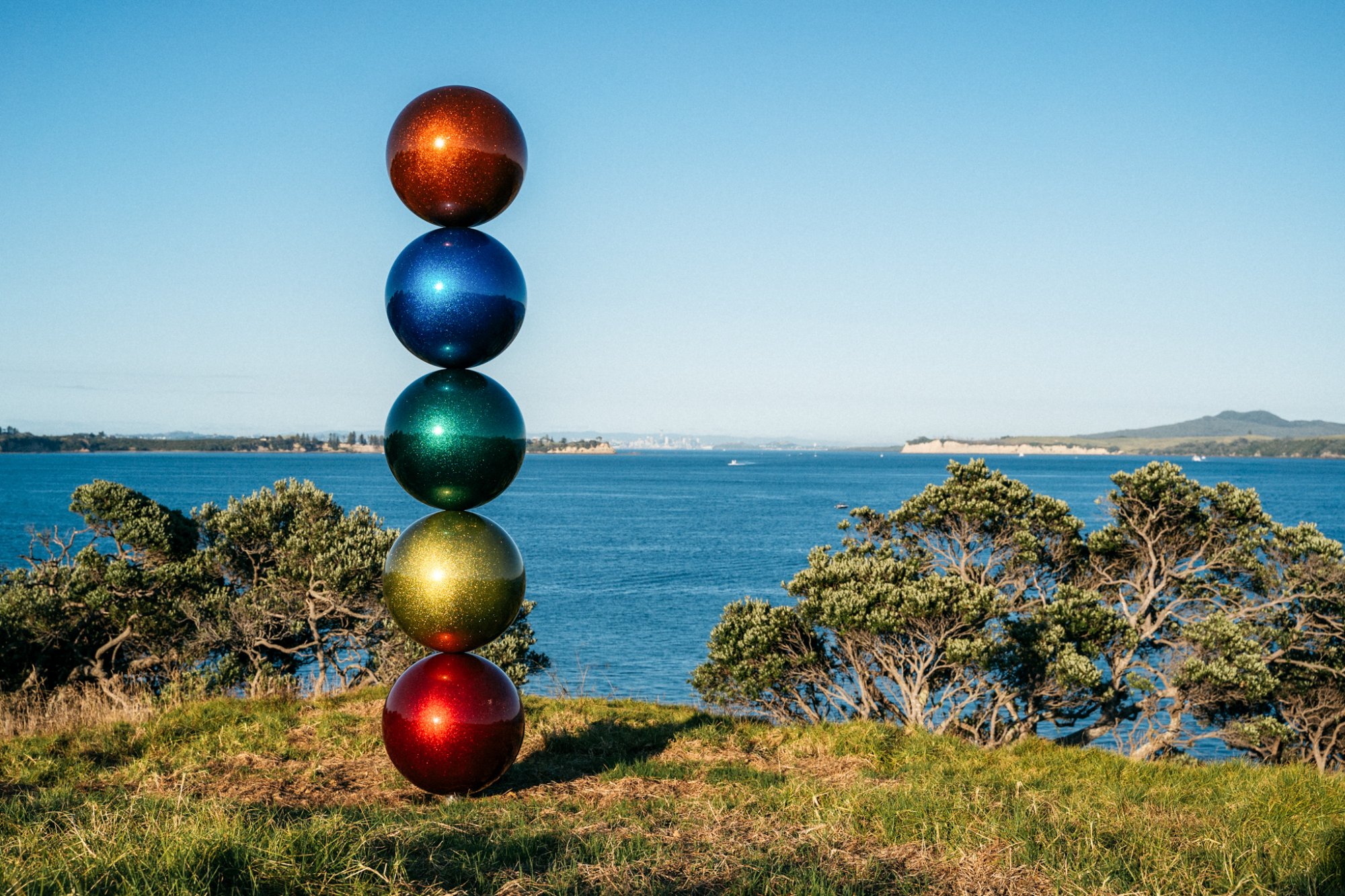
Leon van den Eijkel Round and Round, 2019
Stainless steel and automotive paint, 1000 x 1000 x 5000 mm.
A sphere (from Greek ‘sphaora’, -globe, ball) is a perfectly round geometrical object in three-dimensional space that is the surface of a completely round ball. Like a circle in a two-dimensional space, a sphere is defined mathematically as the set of points that are all at the same distance, ‘r’, from a given point, but in a three-dimensional space. This distance ‘r’ is the radius of the ball, which is made up from all points with a distance less than ‘r’ from the given point, which is the center of the mathematical ball. These are also referred to as the radius and center of the sphere, respectively. The longest straight line through the ball, connecting two points of the sphere, passes through the center and its length is thus twice the radius; it is a diameter of both the sphere and its ball. The distinctive nature of spheres means they are unique. Round and Round celebrates the uniqueness of human technology. Through the Pacific colour palette of the orbs, we celebrate the way the sculpture perfectly balances the thin line between urbanization and nature in this place.

Kazu Nakagawa and Pacific Environments Architects Kæ ́muə Kæ ́muri, 2019
Lawson Cypress, 3800 x 380mm x 2
What links architecture to art? Eliminate utilitarian components like doors, windows, staircases, and you are left with structural form, an assembly of modular building blocks, a naked architecture that echoes its environment; natural building blocks and modular shapes repeated in trees, shells, even molecules.
In this artist-architect collaboration, Kazu Nakagawa accepts the environment in which the sculpture is placed as its own fully rendered modular architecture. He builds backwards from this understanding; disintegrating and decomplexifying to find an organic entry point so the finished work is integral to the environment.
Pronounced “ka mua ka muri” and translating as “looking backwards to move forward”, this work utilises the origami method; simple faceted planes that build into complex physical structures that reflect and form a dialogue with their environment.
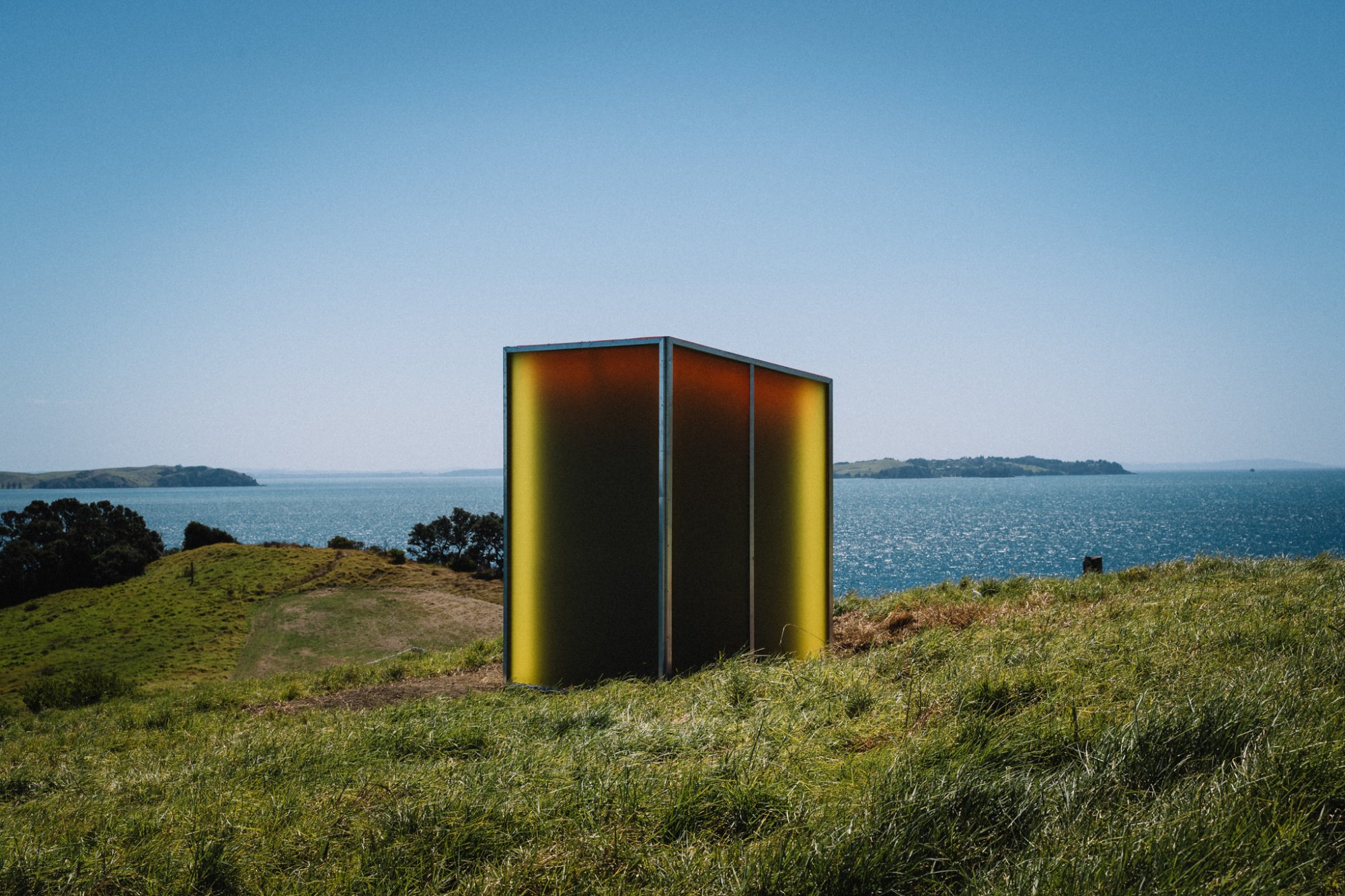
Tyler Jackson Modulating Monolith, 2019
Acrylic glass, stainless steel, and aluminium framing, 2000 x 2000 x 3000 mm.
Modulating Monolith is a site-conditional sculpture located along Te Whetumatarau Point on the North West side of the Waiheke Sculpture on the Gulf Walkway. Constructed using stainless steel, aluminium and acrylic glass, Modulating Monolith references László Moholy-Nagy’s artwork Light-Space Modulator in 1930. Describing the work as a lighting “device used for demonstrating both plays of light and manifestations of movement’ which “can be used to arrive at countless optical conclusions”. Jackson aims to reconstruct Moholy-Nagy’s concept into a participatory transitional approach of perceiving light and colour which visitors will experience the work through navigating the Walkway.
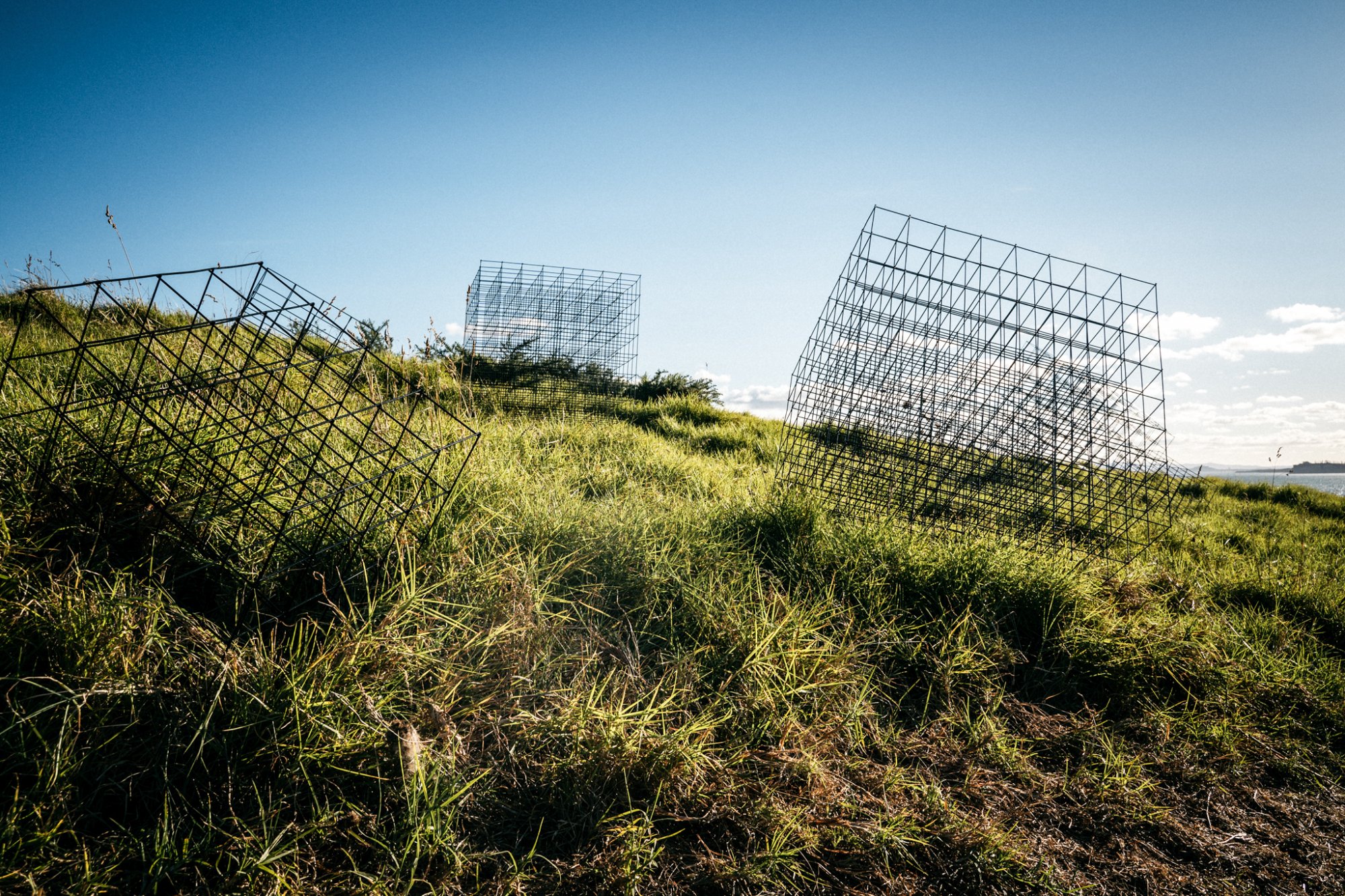
James Russell Rolling Reflections, 2019
16 modular mesh cubes, ranging in size from 500 mm sq. to 2000 mm sq
Rolling Reflections is an abstract representation of tumbling rubble. It uses reflection, repetition and scale to maximize its engagement with its viewers. It draws inspiration from its seaside location and the countless volcanoes throughout Auckland.
The cubes are built from layers of steel mesh creating a 3-dimension mesh grid. This grid creates forever changing views, patterns and shapes. The mesh cubes are static objects, but as viewers navigate through the field of mesh cubes, the changing views, patterns and shapes creates the illusion as if the cubes are tumbling down the hillside.
The cubes are galvanized and then treated with a reflected paint adding another layer to the work. The cubes will shimmer and reflect the sun, enhancing the illusion that these static objects are of tumbling down the hillside.
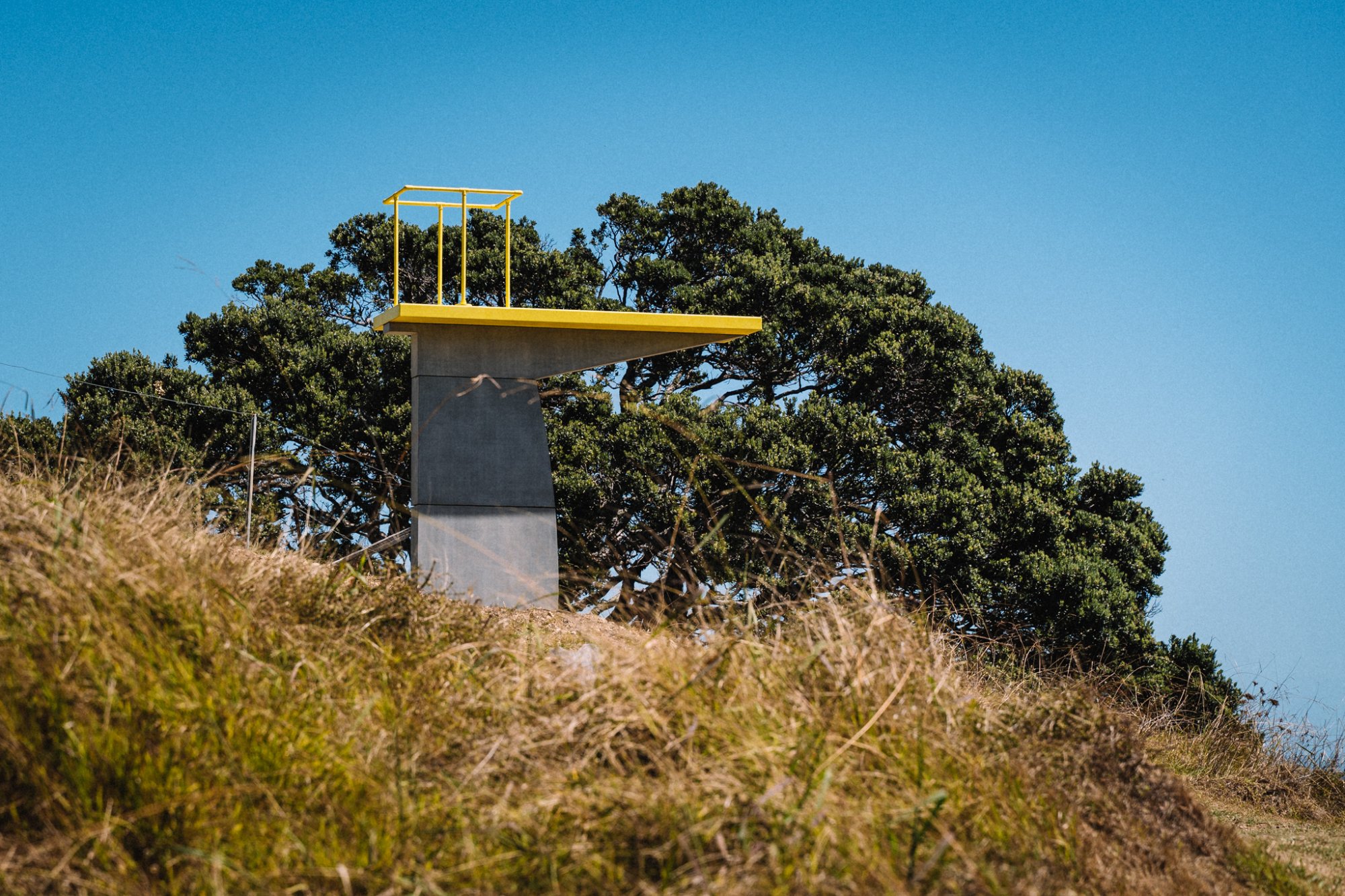
Natalie Guy The Pool, 2018–19
Glass reinforced concrete, galvanised steel, plywood, powder coated aluminium, PVC tubing, 800 x 2200 x 2600 mm.
The Pool was designed specifically for Sculpture on the Gulf 2019. It is part of a wider investigation into disrupting the historical narrative using modernist objects and, more recently, late modernist architectural forms. The Pool was spurred by a visit to the modernist city of Chandigarh, India, in 2017. While researching and traversing the city I became interested in the work of Jane Drew (1911 –1996) an English architect and urban planner. Her role in the design of Chandigarh, particularly the social housing and smaller scale public buildings, seems overlooked, or at least overshadowed by the large civic buildings of Le Corbusier. Her domestic-scale modernism was refreshing, an example being a public swimming pool with diving board in Sector 23.
The pool and board in turn reminded me of David Hockney’s famous and rather more utopian Californian modernist-cool pool paintings. The diving board removed from its poolside and now marooned on a headland has become a surreal object. Inaccessible without stairs, with a closed loop hand-rail – it is functionless. The brutality of bare concrete is now met with the bright and breezy colouring of Hockney in an international melding of late modernist tropes.
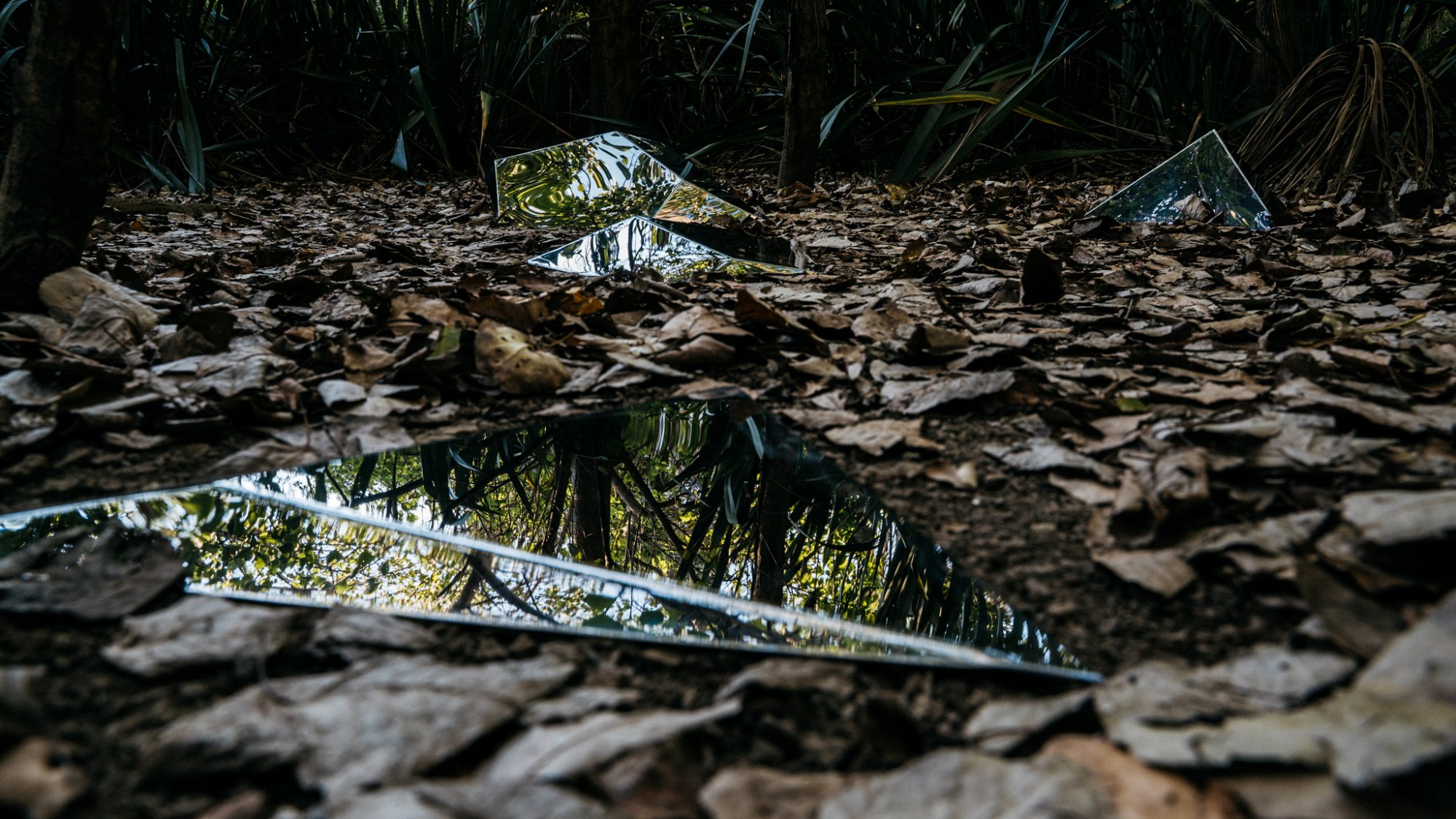
Shelley Simpson Hoax, 2019
Stainless steel, dimensions variable.
In 1852 it was announced that gold had been found on Waiheke. £100 had been offered to anyone who found gold on the Island, and a man named Merrick was claiming the prize. An investigation team set out to the Island to see whether the claim was legitimate, only to find that it was not, and the event became known as the ‘Waiheke Gold Hoax.’
During the 19th century the hunt for gold in NZ was fierce. Fortunes were made and lost, communities were rapidly built and just as quickly abandoned. If gold had been discovered at Waiheke, it would be a different place today. Waiheke offers other riches; as a holiday destination, a place to make wine, a valued home, a place of refuge, a creative centre and a beautiful natural treasure.
The highly reflective surfaces of Hoax reflect our desires back to us, which in the 19th century may have been the riches available to those who extracted minerals from the Earth. Now in the 21st century we look for solutions to the problems we have inherited directly from the types of behaviour that extractive mining was and is part of. Today, we search for a way to navigate the difficulties of living in the Anthropocene, the geological epoch we now inhabit, when, for the first time, human activity is clearly present in the geological record.
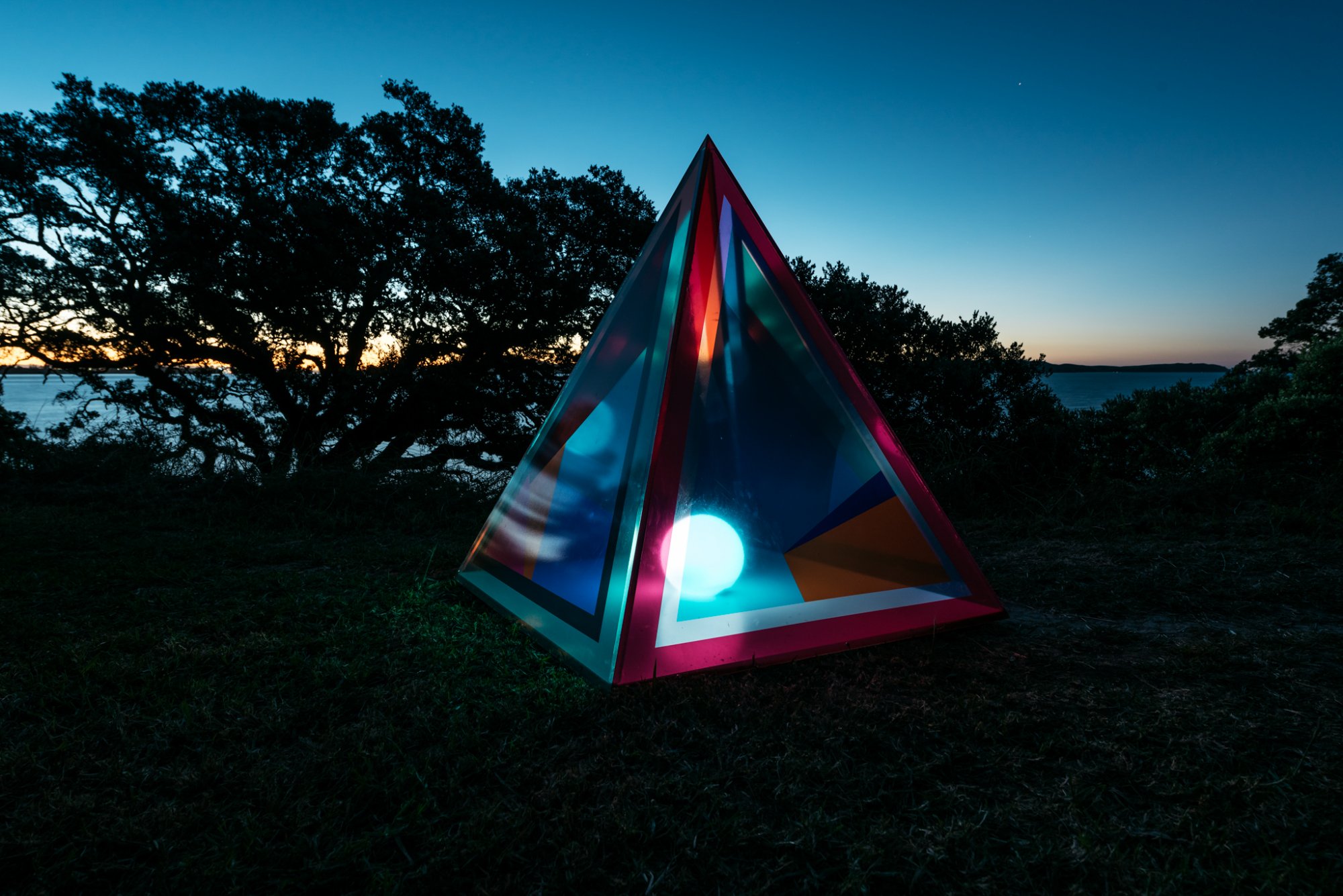
Shannon Novak Extended Play, 2019
High impact plexiglass, acrylic, PVC, transparent vinyl, and solar light, 1200 x 1200 x 1400 mm.
Extended Play explores the limits of site, or how it might extend beyond a designated and/or expected path. It is made up of a central work and satellite works. The central work is located on the walk, a small structure that juts out of the ground like the tip of an iceberg. The satellite works appear in locations outside the walk into and beyond the Waiheke community using transparent vinyl to augment space into colour-rich and interactive environments. Although the works are geographically spread, they are all connected through the same visual language, just as we are all connected through our own biological network.










